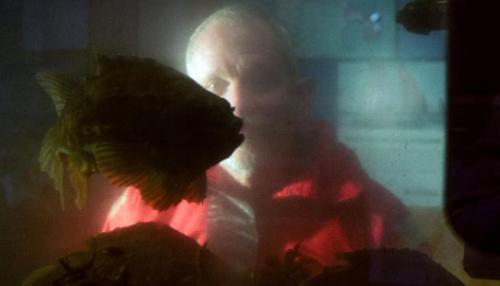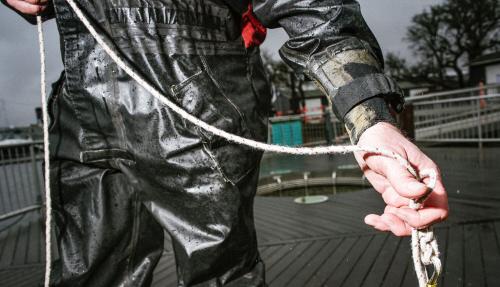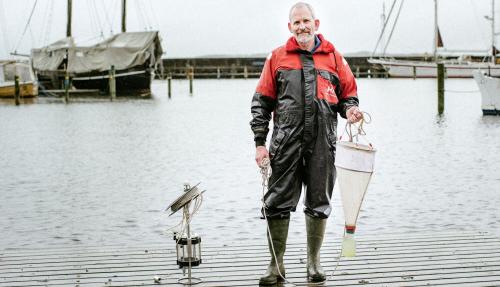Copepods can disrupt marine fish farming

In a new research project, a fish farmer’s everyday issues come face to face with the latest research into copepods. The project, which is supported by the European Maritime and Fisheries Fund (EMFF) and others, aims to study how the laboratory results from Roskilde University can be translated into a stable, industrial outdoor production of copepod larvae year-round. This is an innovation that will ensure access to cheap feed with an optimal biochemical profile for the survival and growth of fish larvae. This is because copepods may be what can ensure a greater survival rate among young fishes, healthier adult fishes and a generally higher quality of fish from fish farms.
“Today, there is a huge global market for live feed. If this market can be disrupted by copepods, there will be a huge potential - not just financially in terms of selling copepods as live feed for fish larvae, but also in terms of farming high-quality fish and at the same time ensuring a greater diversity in the species that are being farmed,” says Benni Winding Hansen.
Since the mid-1980s, he has been researching the ecology, biology and physiology of copepods. Over the last 15 years, this research has been supplemented with application-oriented projects that optimise the industrial production of live feed.
Copepods are nature’s choice
Copepods are the most numerous multi-cellular organisms in the world, and they have a very core position in all water-based ecosystems. Except for the salmonids, all fish larvae depend on live feed, and it is precisely copepod larvae that are the primary food source in nature for fish at the larvae stage.
Copepods get their nutrition from micro-algae that contain a high content of omega-3 and omega-6 fatty acids. The copepods’ fatty acid profile is of critical importance to fish larvae, as they need just the right amount of fatty acid balance in order to develop things such as their nervous system, sensory system and pigmentation optimally.
“It always makes sense to learn from evolution, and copepods are nature’s choice. So it is natural to mass produce copepods and replace the types of live feed that are used today,” says Benni Winding Hansen.
Today, copepods play an almost inconsequential role in the ocean fish farming industry. The industry typically uses live feed based on rotifers and brine shrimp, which both belong naturally in fresh water. They are easy to use in fish farming, but they have low contents of omega-3 and omega-6 fatty acids, and this has negative consequences on the survival and development of the fish larvae, and in the end, also on the production costs.

Luxury production is a showcase
Fishing has stagnated on a global level, and today, around 50% of the total fish production is from fish farms. At the same time, farmed fish is the fastest-growing source of protein in the food industry. In the context of a growing population, the industrial production of fish becomes a necessity.
“The demand for aquaculture farming is huge, and so is the commercial interest in it. Aquaculture, like the pork industry, is a knowledge-based industry. It takes a particularly great deal of research to streamline the industry and make it profitable,” Benni Winding Hansen points out.
Tuna is an obvious next step, as fresh tuna is an expensive and a popular delicacy and that puts a lot of pressure on the tuna stocks in nature.
Raising Yellowtail Kingfish in fish farms is a form of luxury production targeted towards the wealthier consumer segments who are ready to take up their chopsticks and have some sushi and sashimi. It is precisely the high kilo price of the fish that creates room for experimenting with hatching copepods as fish larvae food year-round.
“Yellowtail Kingfish raised in tanks are definitely not a cheap source of protein that can solve the world demand. We are instead testing a new concept on a high-value fish which, at length, can be introduced to the industry on a larger scale once the production methods are well-tested and the costs decrease,” Benni Winding Hansen states.
In the short run, the project is also demonstrating a large commercial potential for a more diverse production of marine fish species:
“We are currently raising relatively few species and the producers can sell as many high-value fish as they can make. Tuna is an obvious next step, as fresh tuna is expensive and a popular delicacy and that puts a lot of pressure on the tuna stocks in nature,” says Benni Winding Hansen.
From dormant eggs to an egg bank
When the production of algae in the boreal oceans decreases during the winter months due to the cold and dark, it is also the end for that years copepods. They lay so-called dormant eggs that drop to the bottom of the sea. It is only when spring arrives that the eggs are whirled up and hatched so that the waters once again become full of copepods.
The year-round production of copepods is based on this same cycle. In a laboratory, Benni Winding Hansen’s research group can simulate nature and they are now capable of storing dormant eggs from the copepod species Acartia tonsa in cool temperatures for a year - and, it should be mentioned, without the eggs losing the ability to hatch.
“For the fish farmers, this means that in the future they will have access to a backup system. If the production of copepods should suffer from disease, accidents or fail in some other way, they can extract material from an “egg bank” based on copepod eggs in cold storage. This makes it possible to produce copepod larvae year-round. This is the exact process that we will be completing on a large scale in the production of Yellowtail Kingfish in northern Jutland,” says Benni Winding Hansen.
Experiments with extending the season for micro-algae - a prerequisite for the farming of copepods - is also part of the production of Yellowtail Kingfish. This is done by covering the outdoor copepod tanks with greenhouses and using artificial lights so that the micro-algae can reproduce for a longer period of the year and ensure that the copepods have food.
If someone thinks that society doesn’t need nerdy basic research and can jump straight to the application phase, they are gravely mistaken.

Stress-free copepods
Over the last couple of years, the research group has succeeded in pushing the boundaries of how densely copepods can be grown. It is a critical issue for commercial production, where every cubic metre of water in the basin is an added expense.
“In order to increase the density, we need to measure the right things. In the beginning, we measured the mortality rate, but it takes a lot to kill a copepod. Instead, we need to measure how when they begin encountering physiological stresses and how long the copepods can reproduce. It’s all about getting some eggs produced. Lately, on the gene level, we have also studied how copepods in crowded cultures become stressed,” says Benni Winding Hansen.
Just as with humans, the oxygen consumption reveals the stress levels in copepods. On that basis, well-being can be measured by the copepods’ oxygen consumptions and patterns of movement, and this has given us new knowledge about how the stress proteins of an organism are activated.
“Previously, the assumption was that there could only be a few thousand copepods per litre of water. Now we have demonstrated that we can have 5,000 - 10,000 copepods per litre before the crowded conditions impact them. This is a huge win, that we can increase the density so much without it having a negative impact on the copepods’ ability to lay eggs,” Benni Winding Hansen explains.
“The entire basis for an innovation project such as this is that I’ve spent 15 years on the research behind it. I know the ecology and physiology of copepods inside and out. If someone thinks that society doesn’t need nerdy basic research and can jump straight to the application phase, they are gravely mistaken. It is precisely because I’ve done my own background research and made my discoveries that I can now implement them in managed aquaculture processes,” Benni Winding Hansen points out.
Facts on marine fish farming
- On a global level, the vast majority of fish farming is in fresh water: Only 15% of the total production is from marine fish farming - i.e., the farming of fish species native to the oceans.
- In Denmark, the vast majority of fish farming is in fresh water too. This is mainly rainbow trout from conventional uses of dams: Danish fish farmers have a century-long tradition of focusing on precisely rainbow trout as they are cheap and relatively simple to produce.
- Despite the fact that fish farming with ocean species remains a modest part of the Danish production, it is an industry that is growing at significant rates. The prices for ocean fish are attractive and the demand far exceeds what is produced.
- The proportion of marine fish that are fish farmed exceeded 50% in 2016 on a global level according to the UN’s Food and Agriculture Organization.
- Using copepods as live feed for young fish makes it possible to farm new types of fish species in salt water - and this may reduce the stresses being put on wild fish stocks such as tuna.
Published in Rubrik #15, 2019